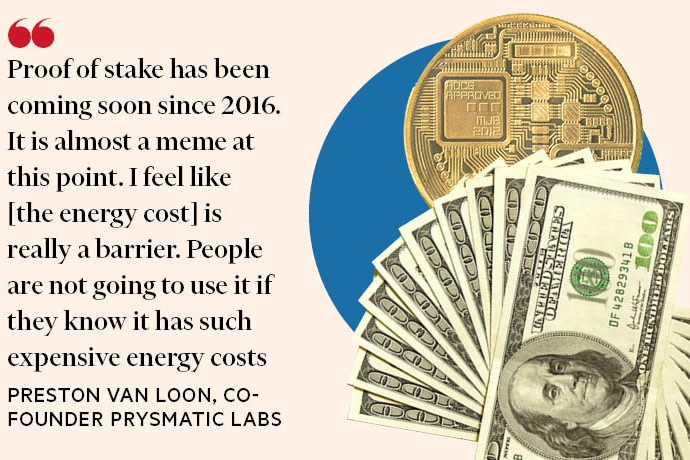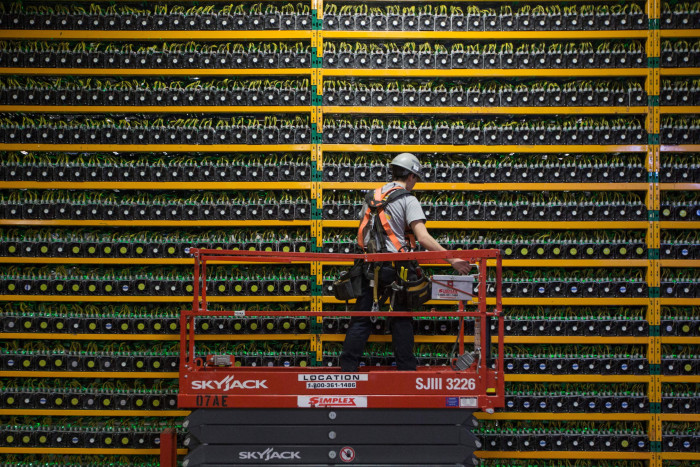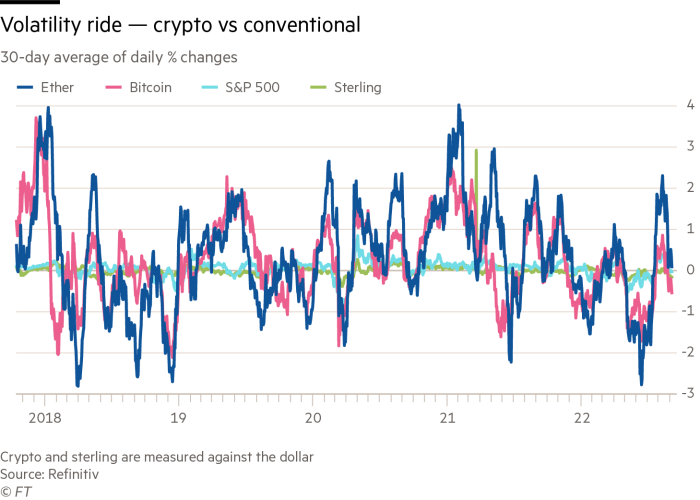
At the Blockchain Futurist Conference in Toronto in early August, Ethereum co-founder Vitalik Buterin stood before an excitable audience to deliver some big news. “The Merge is coming,” he told the crowd, “this effort that we have been working on for basically the last eight years . . . Ethereum will finally become a proof-of-stake system . . . Yay!” The audience cheered.
If there is one thing the crypto community has in good supply, it’s promises. In the relatively short history of digital assets — starting with bitcoin in 2009 — evangelists have trailed a list of innovations that, they say, could solve inflation, revolutionise business, or provide a financial lifeline to people living under authoritarian regimes around the world.
In response, critics of the largely unregulated industry have highlighted its links to criminal activity and huge carbon footprint, not to mention the financial ruin it has brought to many vulnerable people — the same ones industry representatives often claim they want to help.
The faithful now have an opportunity to prove their critics wrong. On the horizon is arguably crypto’s most ambitious project yet, dubbed “the Merge”. The term describes the moment when the Ethereum blockchain will merge with a system called the Beacon Chain. Ethereum is the most popular platform for parts of the Web3 — or “new internet” —world that have tried to enter the mainstream, such as NFTs and decentralised finance.

When the Merge happens, probably sometime this week, the stage will be set for innovations intended to address some of the harshest attacks on the industry. These are high stakes for a project that most people outside the crypto world have never heard of — and that many who have only vaguely understand. If the fusion goes off without a hitch, Ethereum will shift from a “proof-of-work” system to one known as “proof of stake”.
Proof-of-work systems such as the bitcoin and Ethereum blockchains are kept secure by powerful computers. These “nodes” race against each other 24/7 to solve complex mathematical calculations in order to validate each new block of transactions added to the chain. The system defends against individual nodes being able to corrupt the blockchain, but it also demands an immense amount of energy to run. That translates to a carbon footprint too big for environmentalists and crypto-sceptics to stomach.
By contrast, in a proof-of-stake system such as the one Ethereum is moving to, the blockchain doesn’t need powerful computers for its security. Instead, individuals or companies act as the validators, staking their own ether tokens (the native currency of the Ethereum blockchain) as collateral against bad behaviour. They are incentivised to do so by rewards, including the chance to earn fresh ether.
Some see the Merge as a historic moment that will take crypto mainstream by drastically reducing the industry’s levels of energy consumption — the Ethereum blockchain’s annual level is currently estimated to be as high as that of Finland. “This is a pretty critical step for the infrastructure to actually scale, in order for Ethereum to become what it can become — a 24/7, global permissionless capital market,” says Avichal Garg, partner at early stage venture firm Electric Capital.
Noam Hurwitz, a software engineer at Web3 development platform Alchemy, describes it as “the biggest milestone to date of proof [the developers] can execute on their road map”.
But to others, the shift represents a betrayal of the blockchain’s fundamental characteristics — to be an open, transparent and decentralised network, self-policing by design and controlled by no group of individuals. The Merge will not revolutionise the whole Web3 world, and it will not directly solve many of the biggest problems facing the Ethereum blockchain, such as high transaction fees and slow transaction speeds.

Still, after years of talk, a successful Merge at least sets the scene for future innovation, particularly by allowing the Ethereum blockchain to scale and handle heavier workloads. This is good news for the applications that build their businesses on the blockchain, such as the NFT marketplace OpenSea, or decentralised crypto exchanges like Uniswap. Charles Storry, head of growth at crypto index platform Phuture, who works in the niche worlds of decentralised finance and Web3 tech, is full of optimism.
It “is massive for Ethereum and the wider crypto community, because it unlocks new applications which wouldn’t be possible in the existing system, increases scalability and radically improves Ethereum energy efficiency,” he says. “We’re just getting started.”
Gas guzzlers
Despite the hype, whether the Merge really heralds the mainstreaming of crypto projects is a matter of serious doubt. This year’s turmoil in crypto markets has tainted the mood: a crash in coin prices wiped about $2tn off the total value of cryptocurrencies and blockchain-based ventures have been caught in its wake.
Some of the biggest companies in the sector have declared bankruptcy this summer, including hedge fund Three Arrows Capital and lending platform Celsius. Tumbling valuations in the tech world have also threatened to reach deeper into the crypto and fintech sectors.
Ethereum is not the only blockchain in town. Others — such as the bitcoin blockchain — will still use proof-of-work systems after the Merge. According to estimates by Cambridge university, the bitcoin blockchain consumes so much energy that if it were a country, it would rank in the world’s top 35 by energy consumption, surpassing Belgium and Finland.

So why does the Merge matter if other blockchains are still guzzling energy and harming the environment? Alex de Vries, founder of the website Digiconomist, claims the Merge could shed approximately 99 per cent of Ethereum’s current energy consumption.
Even if bitcoin’s dirty climate record is set to continue, de Vries argues any progress towards greening the industry is better than none: “You can’t say we have cleaned up cryptocurrency when the biggest polluter is still out there . . . but I would say this is a massive step forward at the very least . . . the outside world also needs to see that this is possible.”
Many of the “second layer” projects that are built on the Ethereum blockchain (such as NFTs and decentralised finance platforms) will also be affected. “It makes Ethereum greener, which is important because that has actually been a stumbling block to adoption,” says Alkesh Shah, crypto and digital asset strategist at Bank of America. “Many people [who would otherwise] use those digital assets don’t because of the energy use and the negatives for the environment.”
“It’s going to dramatically reduce the carbon footprint for the whole industry,” says Ilan Solot, a partner at venture capital firm Tagus Capital.

Should the Merge successfully inoculate Ethereum against criticism from environmentalists, pressure will grow on its main rival, bitcoin. If one of the two most prominent blockchains can ditch its dirty reputation, why not the other?
Ethereum core developer Preston Van Loon, who co-founded Prysmatic Labs, a team of software engineers dedicated to building the Ethereum blockchain, says the Merge cannot come soon enough. “Proof of stake has been coming soon since 2016 . . . it’s almost a meme at this point,” he says. “I feel like [the energy cost] is really a barrier to global scale, people are not going to use it if they know it has such expensive energy costs.”
Changing engines mid-flight
The carbon footprint problem has been a persistent hurdle to efforts to push blockchain technology to mainstream users, says Ryan Wyatt, former head of gaming at YouTube who now runs blockchain gaming company Polygon Studios. The Merge “really does away with that in its entirety,” he says. “You can then focus on what the other points of friction are for onboarding the next billion users into Web3.”
But others in the industry say Ethereum’s problems with slow transactions and high fees will continue to disqualify the blockchain from driving any kind of Web3 revolution. “I don’t understand this insistence of using something [Ethereum] that at its core, doesn’t work very well,” says Lars Seier Christensen, co-founder of Saxo Bank who now runs a proof-of-stake blockchain called Concordium.
What is more, there is no guarantee the Merge will even work from a technical perspective. The process has already been set in motion and will happen once a pre-determined target on the blockchain is reached — currently expected to happen as early as Tuesday. The Merge will be gradual, more like the sun coming up than switching on a light.
“It’s almost like changing the engines on a plane whilst flying it . . . a significant engineering feat,” says Edward Machin, a senior lawyer in Ropes & Gray’s data, privacy and cyber security practice.

Even if the big moment does come off without a hitch, there are plenty of risks that lie in wait. The first is a theoretical one: dubbed the “51 per cent attack”. Post-Merge, the Ethereum blockchain will be secured by a group of individuals by virtue of the ether tokens they have staked. That means, in theory, that any group or individual who gains control of 51 per cent or more of the staked ether on the blockchain would effectively control the system.
It is an unlikely scenario — not least because it would probably be prohibitively expensive to own over half the staked ether on the blockchain. But also because an attacker would lose their staked holdings if they tried to meddle with the chain. “I would think smaller blockchains may have a higher risk for that,” says Shah.
Still, the danger is there and crypto sceptics have witnessed enough hacks and collapses not to dismiss it. “It’s a high stakes test . . . The hackers aren’t going to come out until it’s live,” says crypto critic and angel investor Liron Shapira. Another critic, software engineer Stephen Diehl, says it is dangers such as these that make people who are considering investing in crypto markets think twice, because “there is this underlying platform risk where, unlike [with] physical commodities, crypto assets can simply cease to exist due to technical black swan events.”
A more immediate problem is the tail risk of a whole series of market mechanisms that have yet to be tested in the wild. “Humans are pretty bad at pricing tail risk. I think most people are probably not thinking about [it], and there are a lot of risks here,” says Garg of Electric Capital.
Existential angst
The most urgent concern for many Ethereum backers is the existential question that proof of stake presents to “decentralisation” — a sacred tenet among advocates of blockchains.
According to DeFi Llama, a popular analytics website, the Ethereum blockchain holds over 50 per cent of the total value of the decentralised finance industry, which champions direct peer-to-peer transactions and is meant to remove all need for third-party intermediaries such as banks or brokers. Like other blockchains, Ethereum is meant to be censorship-resistant. Its design is supposed to hold out against powerful individuals or entities seeking to exert control over other participants.

But in its new guise, safeguarded by a collection of individuals or companies, Ethereum loses that autonomy. “You have what is a shining beacon of decentralisation but in a new model it will be more centralised than people think,” says Machin.
This problem has become clearer since the US Treasury’s Office of Foreign Assets Control (Ofac) last month imposed sanctions against Tornado Cash, an Ethereum-based platform that the government accused of facilitating billions-worth of laundered crypto. The staunchest of crypto’s libertarian army had said the heavy hand of government would prove ineffective against the kinds of “smart contracts” — computer software designed to automate transactions — that run on decentralised platforms. Yet, sanctions have proved effective after all. In the weeks since Tornado Cash was targeted, transactions on the platform nosedived.
That worry is bound to cross the minds of Ethereum’s future guardians, including exchanges Binance and Coinbase, and staking platform Lido Finance. According to Nansen data, these companies are already some of the biggest Ethereum staking players around, and thus will be trusted to secure the network post-Merge. Last month, Coinbase chief executive Brian Armstrong said his exchange would likely quit the staking business before censoring the network.

As guardians of the Ethereum network, these entities will have to decide whether or not to validate and process blocks of transactions that may contain transactions coming from entities under sanctions such as Tornado Cash. That hardly sounds like the censorship-resistant utopia envisioned by the idealists — although critics of bitcoin point out that the concentration of miners (who are overwhelmingly based in certain countries such as the US and Russia) in that blockchain also amounts to a centralised system.
If the Merge does usher in a new era of centralisation, those idealists may have to pack their bags and leave. “If people are worried . . . OK, great, go somewhere else,” says Jeff Dorman, chief investment officer at asset management firm Arca.
There is another reason for optimism: since July, the price of ether — as well as of other popular cryptocurrencies — has partly rebounded, giving investors some respite following a turbulent few months. When BlackRock, the world’s largest asset management firm, launched a bitcoin private trust last month, it signalled that the beleaguered industry might already be repositioning itself for the next bull market cycle.

If the price of digital assets — and, more specifically, ether — should revive, then it is likely that the post-Merge Ethereum blockchain will be one of the biggest beneficiaries of another crypto bull run. “I like to call it the lazy man’s ETF,” says Dorman. “By owning ether, you now have exposure to stablecoins, you have exposure to NFTs, you have exposure to decentralised finance.”
Even so, Dorman is not convinced that wider interest in decentralised finance will necessarily follow from the Merge. That, he feels, is “a separate conversation”. “Do [people] want to take loans through [DeFi] rather than walking into a bank? Do people want to trade digital collectibles rather than traditional baseball cards or stamps? All those factors, user growth, transaction growth, volume growth, those are independent of the Merge,” he says.
Ultimately, answers to these questions will become clear once the Merge happens. Plenty of dry-run merges have taken place on “testnets” — essentially non-live blockchains — the most recent just last month. But there’s nothing quite like the real thing.
Additional reporting by Richard Waters in San Francisco and Joshua Oliver in London








